Page 1020 of 1082
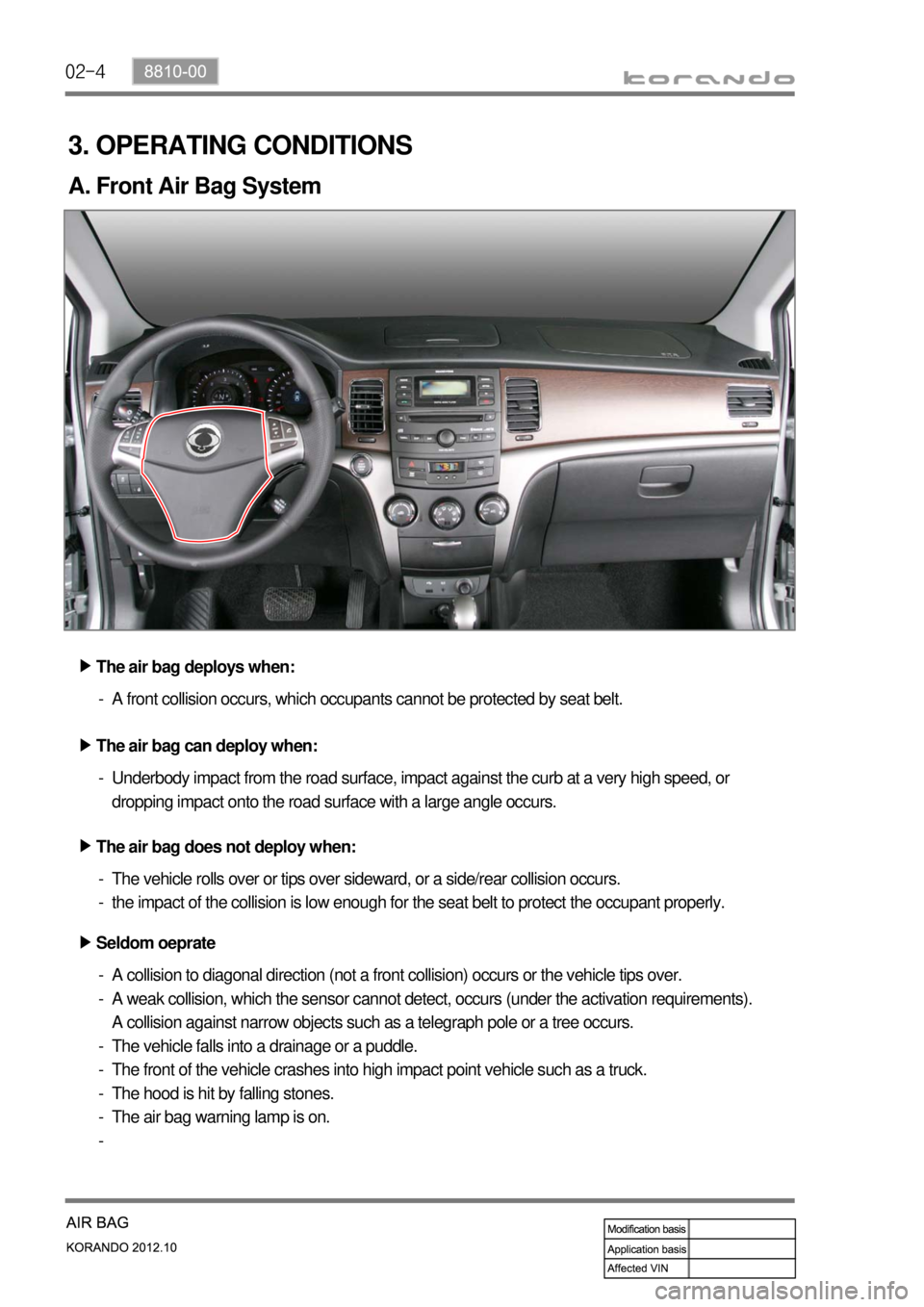
02-4
3. OPERATING CONDITIONS
A. Front Air Bag System
The air bag does not deploy when: ▶The air bag deploys when: ▶
The air bag can deploy when: ▶A front collision occurs, which occupants cannot be protected by seat belt. -
The vehicle rolls over or tips over sideward, or a side/rear collision occurs.
the impact of the collision is low enough for the seat belt to protect the occupant properly. -
-Underbody impact from the road surface, impact against the curb at a very high speed, or
dropping impact onto the road surface with a large angle occurs. -
Seldom oeprate ▶
A collision to diagonal direction (not a front collision) occurs or the vehicle tips over.
A weak collision, which the sensor cannot detect, occurs (under the activation requirements).
A collision against narrow objects such as a telegraph pole or a tree occurs.
The vehicle falls into a drainage or a puddle.
The front of the vehicle crashes into high impact point vehicle such as a truck.
The hood is hit by falling stones.
The air bag warning lamp is on. -
-
-
-
-
-
-
Page 1022 of 1082
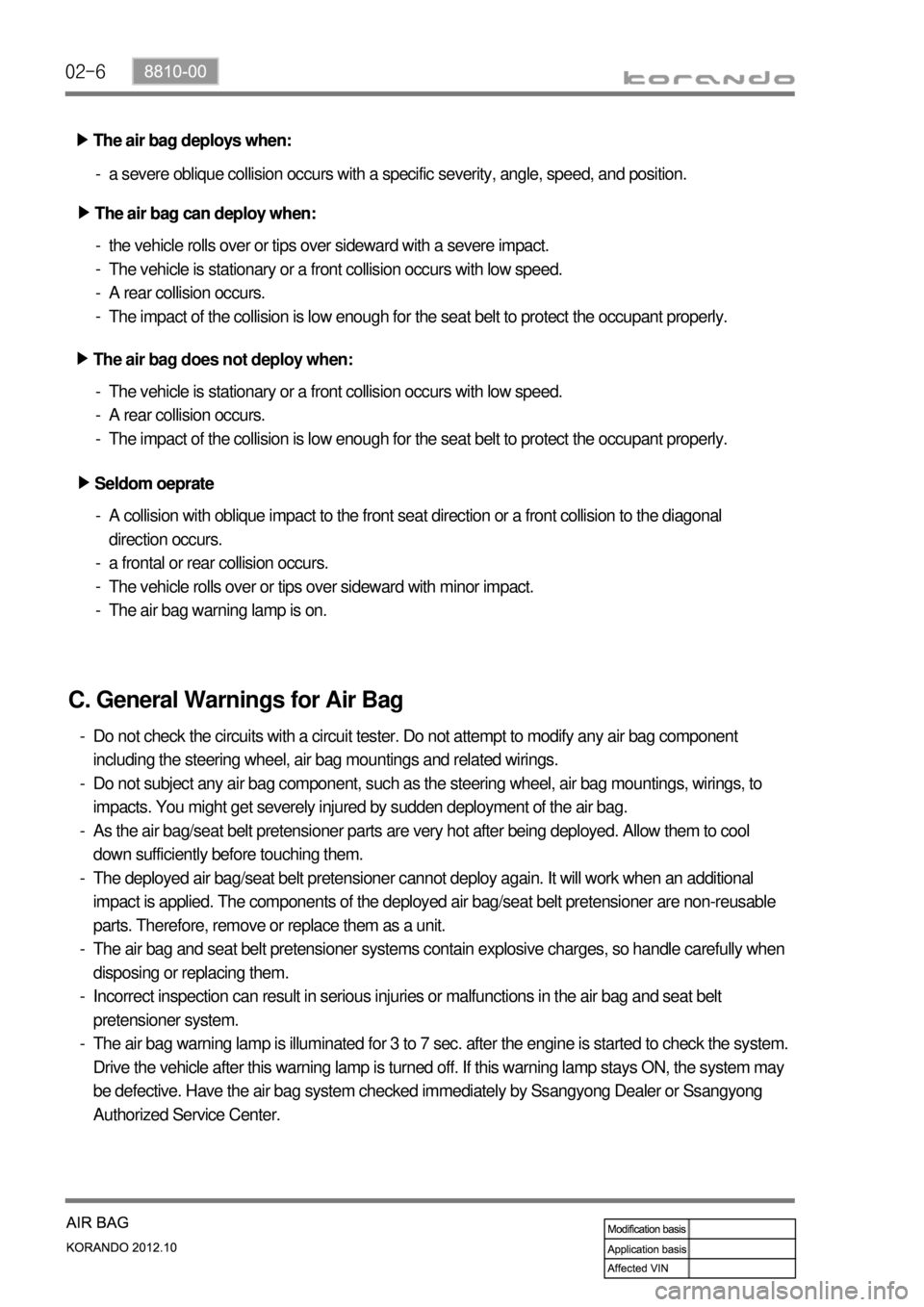
02-6
Seldom oeprate ▶The air bag deploys when: ▶
The air bag can deploy when: ▶a severe oblique collision occurs with a specific severity, angle, speed, and position. -
A collision with oblique impact to the front seat direction or a front collision to the diagonal
direction occurs.
a frontal or rear collision occurs.
The vehicle rolls over or tips over sideward with minor impact.
The air bag warning lamp is on. -
-
-
-the vehicle rolls over or tips over sideward with a severe impact.
The vehicle is stationary or a front collision occurs with low speed.
A rear collision occurs.
The impact of the collision is low enough for the seat belt to protect the occupant properly. -
-
-
-
Seldom oeprate ▶The air bag deploys when: ▶
The air bag can deploy when: ▶
The air bag does not deploy when: ▶
The vehicle is stationary or a front collision occurs with low speed.
A rear collision occurs.
The impact of the collision is low enough for the seat belt to protect the occupant properly. -
-
-
C. General Warnings for Air Bag
Do not check the circuits with a circuit tester. Do not attempt to modify any air bag component
including the steering wheel, air bag mountings and related wirings.
Do not subject any air bag component, such as the steering wheel, air bag mountings, wirings, to
impacts. You might get severely injured by sudden deployment of the air bag.
As the air bag/seat belt pretensioner parts are very hot after being deployed. Allow them to cool
down sufficiently before touching them.
The deployed air bag/seat belt pretensioner cannot deploy again. It will work when an additional
impact is applied. The components of the deployed air bag/seat belt pretensioner are non-reusable
parts. Therefore, remove or replace them as a unit.
The air bag and seat belt pretensioner systems contain explosive charges, so handle carefully when
disposing or replacing them.
Incorrect inspection can result in serious injuries or malfunctions in the air bag and seat belt
pretensioner system.
The air bag warning lamp is illuminated for 3 to 7 sec. after the engine is started to check the system.
Drive the vehicle after this warning lamp is turned off. If this warning lamp stays ON, the system may
be defective. Have the air bag system checked immediately by Ssangyong Dealer or Ssangyong
Authorized Service Center. -
-
-
-
-
-
-
Page 1023 of 1082
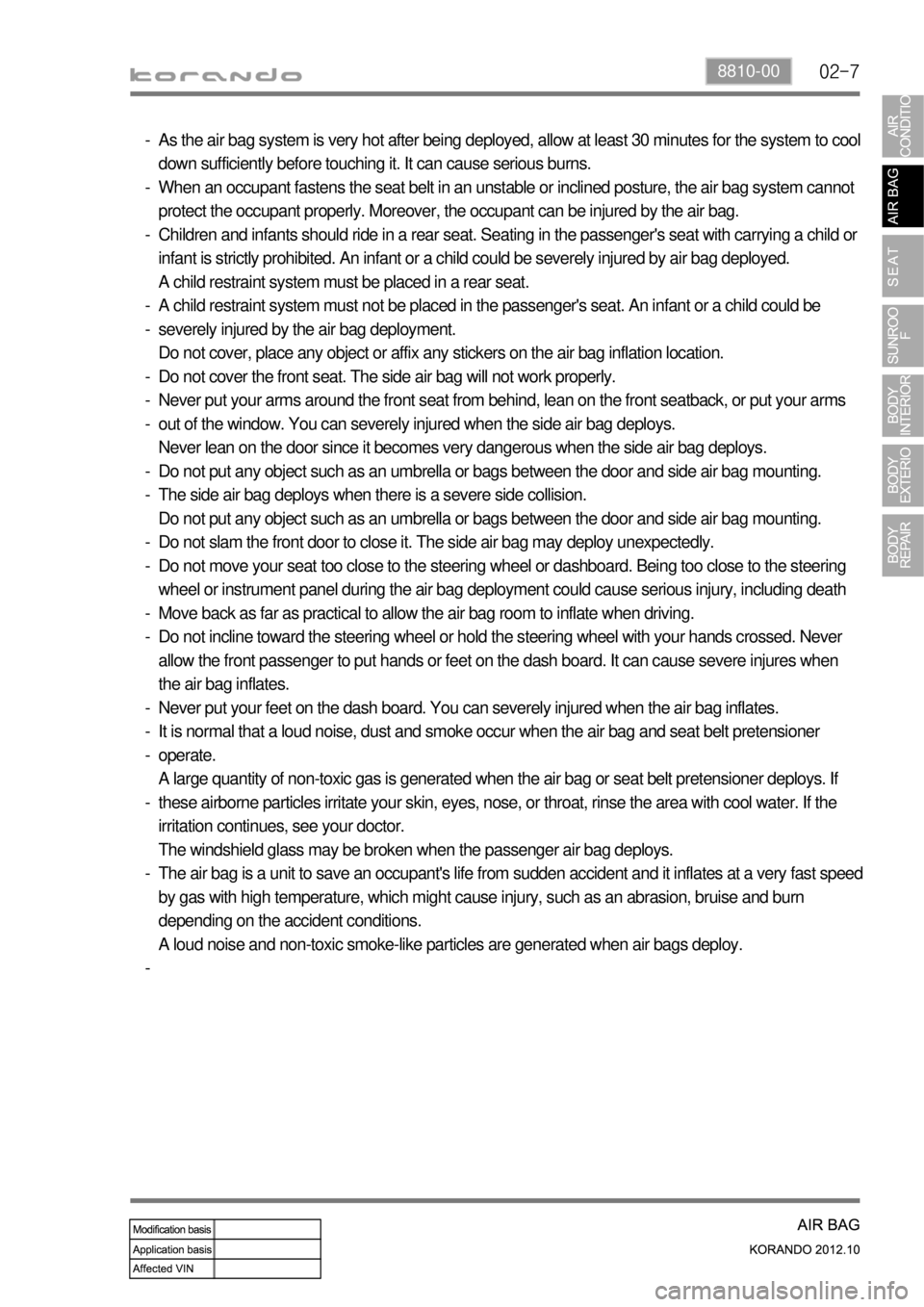
02-78810-00
As the air bag system is very hot after being deployed, allow at least 30 minutes for the system to cool
down sufficiently before touching it. It can cause serious burns.
When an occupant fastens the seat belt in an unstable or inclined posture, the air bag system cannot
protect the occupant properly. Moreover, the occupant can be injured by the air bag.
Children and infants should ride in a rear seat. Seating in the passenger's seat with carrying a child or
infant is strictly prohibited. An infant or a child could be severely injured by air bag deployed.
A child restraint system must be placed in a rear seat.
A child restraint system must not be placed in the passenger's seat. An infant or a child could be
severely injured by the air bag deployment.
Do not cover, place any object or affix any stickers on the air bag inflation location.
Do not cover the front seat. The side air bag will not work properly.
Never put your arms around the front seat from behind, lean on the front seatback, or put your arms
out of the window. You can severely injured when the side air bag deploys.
Never lean on the door since it becomes very dangerous when the side air bag deploys.
Do not put any object such as an umbrella or bags between the door and side air bag mounting.
The side air bag deploys when there is a severe side collision.
Do not put any object such as an umbrella or bags between the door and side air bag mounting.
Do not slam the front door to close it. The side air bag may deploy unexpectedly.
Do not move your seat too close to the steering wheel or dashboard. Being too close to the steering
wheel or instrument panel during the air bag deployment could cause serious injury, including death
Move back as far as practical to allow the air bag room to inflate when driving.
Do not incline toward the steering wheel or hold the steering wheel with your hands crossed. Never
allow the front passenger to put hands or feet on the dash board. It can cause severe injures when
the air bag inflates.
Never put your feet on the dash board. You can severely injured when the air bag inflates.
It is normal that a loud noise, dust and smoke occur when the air bag and seat belt pretensioner
operate.
A large quantity of non-toxic gas is generated when the air bag or seat belt pretensioner deploys. If
these airborne particles irritate your skin, eyes, nose, or throat, rinse the area with cool water. If the
irritation continues, see your doctor.
The windshield glass may be broken when the passenger air bag deploys.
The air bag is a unit to save an occupant's life from sudden accident and it inflates at a very fast speed
by gas with high temperature, which might cause injury, such as an abrasion, bruise and burn
depending on the accident conditions.
A loud noise and non-toxic smoke-like particles are generated when air bags deploy. -
-
-
-
-
-
-
-
-
-
-
-
-
-
-
-
-
-
-
-
Page 1024 of 1082
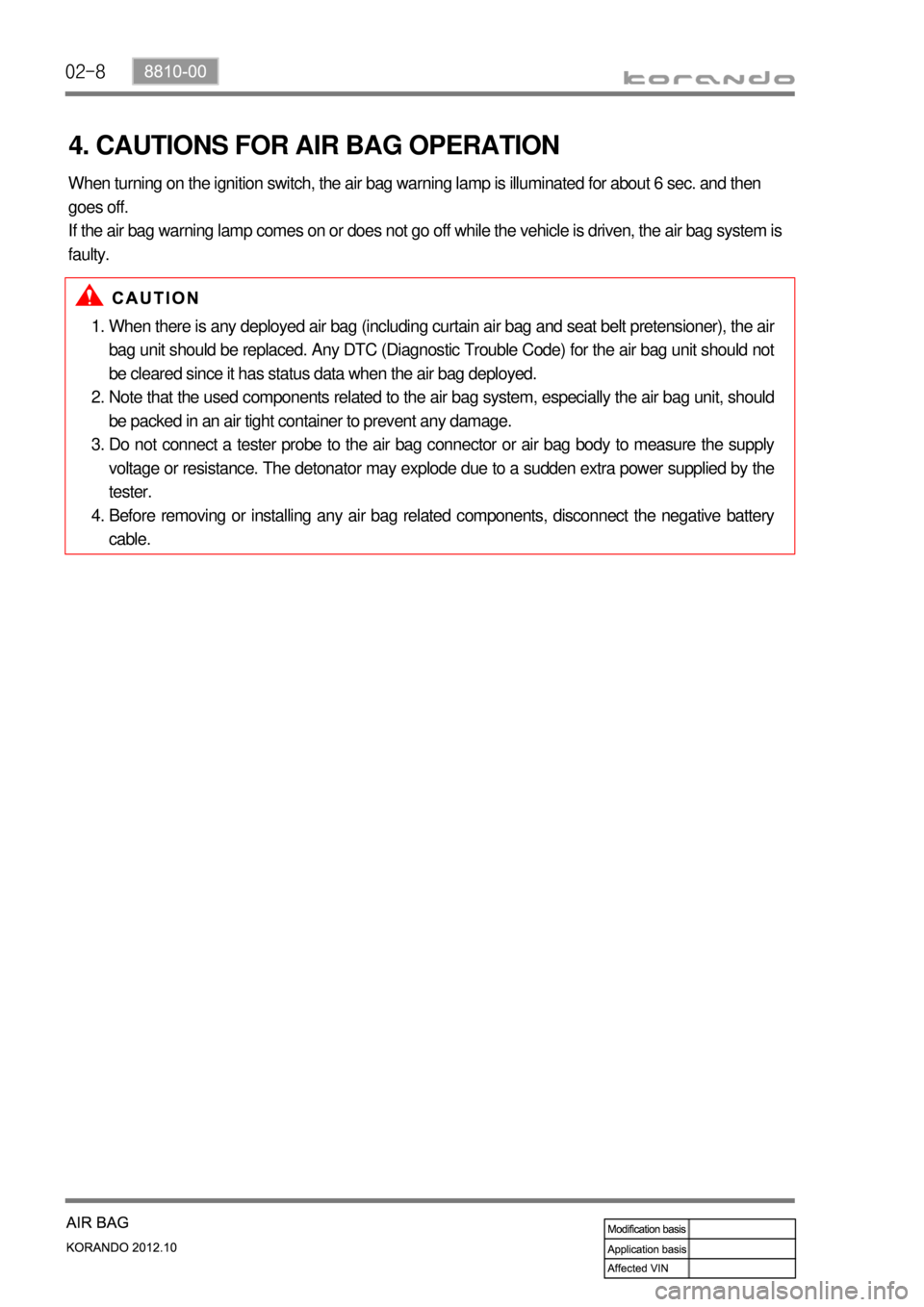
02-8
4. CAUTIONS FOR AIR BAG OPERATION
When there is any deployed air bag (including curtain air bag and seat belt pretensioner), the air
bag unit should be replaced. Any DTC (Diagnostic Trouble Code) for the air bag unit should not
be cleared since it has status data when the air bag deployed.
Note that the used components related to the air bag system, especially the air bag unit, should
be packed in an air tight container to prevent any damage.
Do not connect a tester probe to the air bag connector or air bag body to measure the supply
voltage or resistance. The detonator may explode due to a sudden extra power supplied by the
tester.
Before removing or installing any air bag related components, disconnect the negative battery
cable. 1.
2.
3.
4. When turning on the ignition switch, the air bag warning lamp is illuminated for about 6 sec. and then
goes off.
If the air bag warning lamp comes on or does not go off while the vehicle is driven, the air bag system is
faulty.
Page 1026 of 1082
02-10
Driver side air bagSeat Belt Pretensioner
SDM unit assembly
BCM
Driver air bag module Passenger air bag module
1. SYSTEM CONFIGURATION
Page 1028 of 1082
02-12
2. OPERATING CONDITIONS
1) Front Air Bag Operating Conditions When A Frontal Impact
Occurs
2) Side Air Bag Operating Conditions When A Side Impact Occurs
Impact to Left direction Right direction
Seat belt pretensioner - Driver side IGN IGN
Seat belt pretensioner - Passenger side IGN IGN
Side air bag module - Passenger side IGN Not ignite
Side air bag module - Passenger side Not ignite IGN
Inflatable curtain air bag module - Driver side IGN Not ignite
Inflatable curtain air bag module - Passenger side Not ignite IGN
Impact to Front side
Driver air bag IGN
Passenger air bag IGN
Seat belt pretensioner - Driver side IGN
Seat belt pretensioner - Passenger side IGN
Once the ignition starts, the SDM starts to diagnose the air bag system during the ignition process.
If the system is OK, the SDM is armed for a specific impact on the vehicle. The ignition time takes about
6 sec.
Page 1029 of 1082
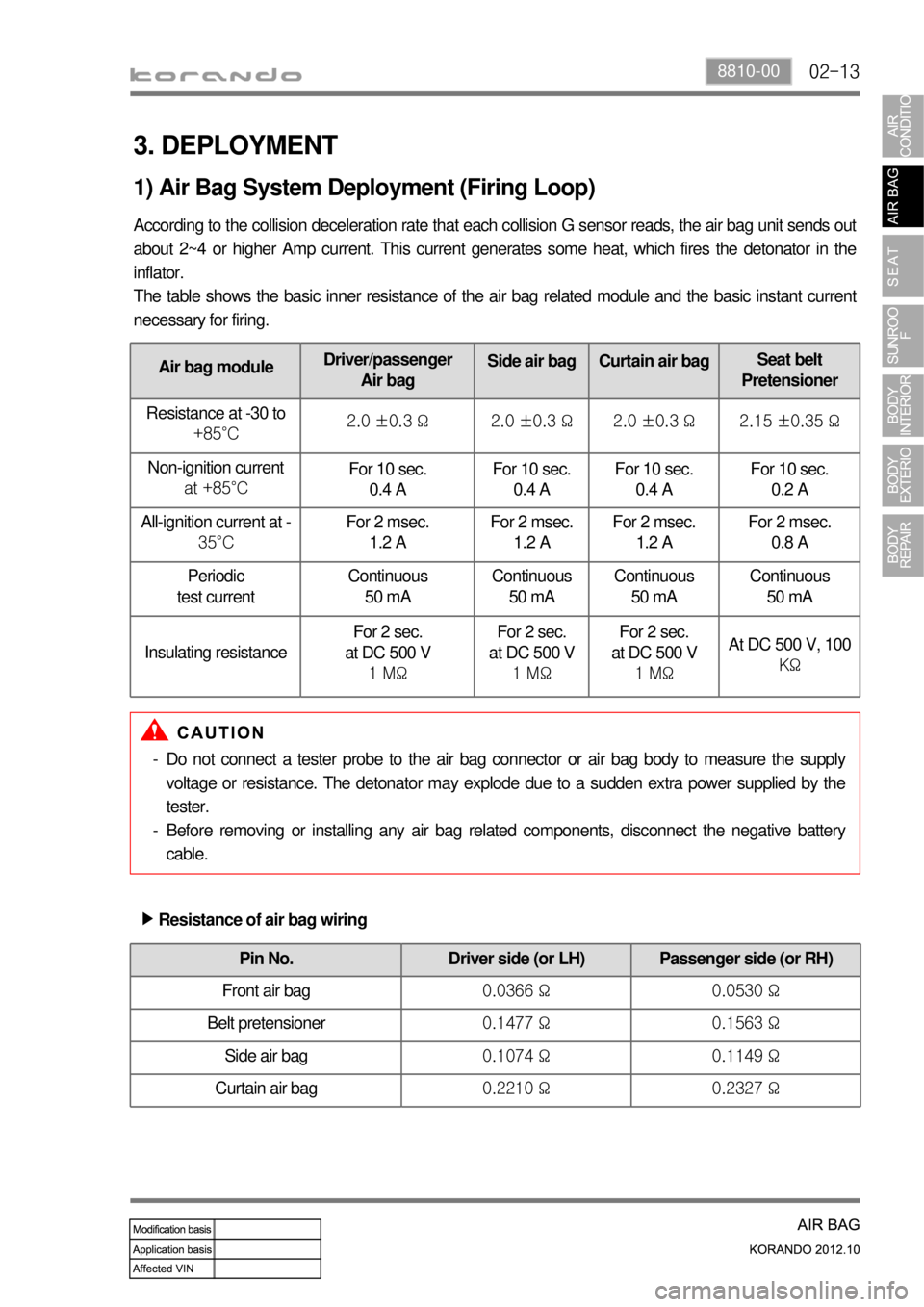
02-138810-00
Air bag moduleDriver/passenger
Air bagSide air bag Curtain air bagSeat belt
Pretensioner
Resistance at -30 to
+85°C2.0 ±0.3 Ω 2.0 ±0.3 Ω 2.0 ±0.3 Ω 2.15 ±0.35 Ω
Non-ignition current
at +85°CFor 10 sec.
0.4 A For 10 sec.
0.4 AFor 10 sec.
0.4 AFor 10 sec.
0.2 A
All-ignition current at -
35°CFor 2 msec.
1.2 AFor 2 msec.
1.2 AFor 2 msec.
1.2 AFor 2 msec.
0.8 A
Periodic
test currentContinuous
50 mAContinuous
50 mAContinuous
50 mAContinuous
50 mA
Insulating resistanceFor 2 sec.
at DC 500 V
1 MΩFor 2 sec.
at DC 500 V
1 MΩFor 2 sec.
at DC 500 V
1 MΩ
At DC 500 V, 100
KΩ
3. DEPLOYMENT
According to the collision deceleration rate that each collision G sensor reads, the air bag unit sends out
about 2~4 or higher Amp current. This current generates some heat, which fires the detonator in the
inflator.
The table shows the basic inner resistance of the air bag related module and the basic instant current
necessary for firing.
1) Air Bag System Deployment (Firing Loop)
Do not connect a tester probe to the air bag connector or air bag body to measure the supply
voltage or resistance. The detonator may explode due to a sudden extra power supplied by the
tester.
Before removing or installing any air bag related components, disconnect the negative battery
cable. -
-
Pin No. Driver side (or LH) Passenger side (or RH)
Front air bag 0.0366 Ω 0.0530 Ω
Belt pretensioner 0.1477 Ω 0.1563 Ω
Side air bag 0.1074 Ω 0.1149 Ω
Curtain air bag 0.2210 Ω 0.2327 Ω
Resistance of air bag wiring ▶
Page 1036 of 1082
03-37410-00
Pin No.Front heated
(driver seat)Front heated
(passenger seat)Rear seats
Type Manual Manual 6 steps Manual 4 steps 4:6 split
Automatic Power (Electric)
6 steps--
Height adjuster Manual±25 mm
(pumping type)--
Automatic± 25 mm--
Sliding 240 mm
(190+50 mm)240 mm
(190+50 mm)-
Reclining66˚ (20+46˚) 66˚ (20+46˚) 17.5˚ (7+10.5˚)
Lumbar support 2 steps (standard) - -
Seat warmer
(cushion & seatback)ON (high, low)
OFFON (high, low)
OFFON/OFF
Head
restraintConvent
ional Up/Down 90 mm
(15 mm x 6)90 mm
(15 mm x 6)45 mm
(15 mm x 3)
Sliding 24 mm
(8 mm x 3)24 mm
(8 mm x 3)-
Electronic active type Optional
(tilting, 15˚)Optional
(tilting, 15˚)-
Seat belt 3-point type, ELR, PT,
L/L3-point type, ELR,
PT, L/LLH/RH & Center:
3-point type, ELR
Seatback pocket Net type/Leather Net type/Leather -
1. SPECIFICATIONS
Fabric seat: Net type seatback pocket
Leather seat: Leather band type seatback pocket -
-